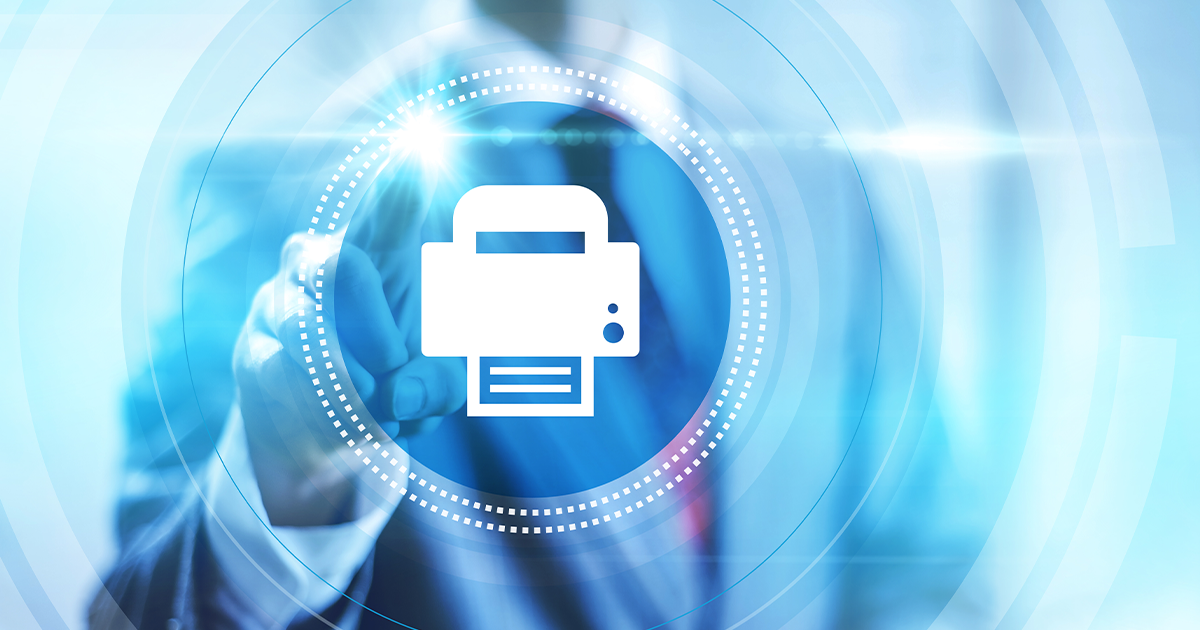Today’s printers have the “brain” of a computer as these devices typically have an operating system, memory and applications. In addition they are often connected to a network (just like any other computer) and can be accessed via WiFi-enabled devices.
While printers are basically a computer that prints, businesses of all sizes unfortunately forget to include their print fleet as a part of their network security plan. If left unsecured, these devices could become a gateway for a threat actor to access your network.
Here’s what you need to know about printer security:
What are the security risks associated with a networked printer?
Networked devices, such as printers, are vulnerable to cyberattacks – just like any computer-enabled device. Learning the security risks that your printers could pose is the first step toward securing your print fleet from outside threat actors looking to get into your network.
Risks to Your Printer
If a threat actor discovers an unsecured printer, they could choose to do harm by hijacking your device. Once outside control is gained, the threat actor could intercept jobs being sent to the printer, view past print jobs to search for potentially sensitive data, manipulate your device to spew out print jobs of their choice or worse yet, dive deeper into your network.
Risks to Your Network
Gaining access to a print network is often only the start of a threat actor’s activity. Chances are that their ultimate goal is to attack other networked systems and gain more data from your organization – such as confidential information about your employees, your business and your customers.
Risks to Your Organization
Once inside your network, a threat actor could release a malicious virus that executes harmful code designed to lock you out of your data and potentially hold it for ransom. This could be devastating to your organization by snarling employee productivity, damaging relationships with customers and causing your business to lose money.
How often do threat actors target networked printers?
According to an industry study by Quocirca, 68 percent of organizations have experienced a data loss due to unsecured printing practices within the past year. While some of these losses were due to employees unintentionally leaving a document on a printer, others were due to threat actors gaining access through unsecured printer settings.
Could your printer be unsecured? We suggest that you ask your IT team about your organization’s current secure printing practices and if they need to be updated. Otherwise, an unsecured printer could provide an easy gateway for a threat actor to enter and access your private data.
How will I know if my printer was hacked?
If your printer is not responding, prints unknown print jobs or refuses to install security updates – it may have been infected by a virus or other malware. In fact, too often organizations discover a hacked printer by receiving a ransom notice from a threat actor.
Being proactive about your printer security will serve your organization well, as fending off attack threats will be less costly than trying to recover from a data ransom situation.
If my printer has a virus, how can I remove it?
If you suspect that your printer may have a virus, notify your IT team immediately. If the concern turns out to be a virus, they will be able to properly contain, diagnose and remedy the situation. However, these same symptoms could also indicate a software issue requiring a device restart or a print driver update and may not be due to a virus.
Don’t take that risk. Allow the professionals to take a look and determine the cause of your printing problem.
How can I better safeguard my printer from cyberthreats?
When you implement print security best practices, you will reduce the risk of a threat actor gaining access to your print fleet.
Here’s seven network printer security best practices to keep in mind:
- Secure the Network – Secure your network traffic with IPSec and 802.1x protocols.
- Secure Your Machines – Change default device passwords, turn off Internet Printing Protocol and use an encrypted connection when accessing control panels.
- Get Up to Date – Keep firmware updated on your devices.
- Implement Image Overwrite – Encrypt data stored on hard drives.
- Control Access – Add print user authentication through the use of a password, PIN or security badge.
- Collaborate with Stakeholders to Create a Print Security Plan – Being prepared is the best practice of all. Include what to do in the even of a security breach and how to restore any lost information as a part of your plan.
- Execute a Plan to Continually Monitor the Security of Your Print Environment – Continuous monitoring is recommended along with quarterly or monthly audits.
Your Complete Managed Print Services Partner
Gordon Flesch Company’s Managed Print Services include enterprise-level print security that protects you and your organization against cyber threats and other potentially harmful activities. Our goal as your partner is to inform you of valuable information related to print security best practices, potential threats and solutions that will enhance your organization’s overall security. We take this responsibility seriously as we keep a vigilant eye on the practices of our manufacturer partners and customers alike to ensure that, as a team, we’re doing everything in our power to safeguard your systems.
Want to learn more? Click the link below to download your complimentary copy of our Quick Guide to Print Security, filled with facts and advice to better secure your printer fleet.










